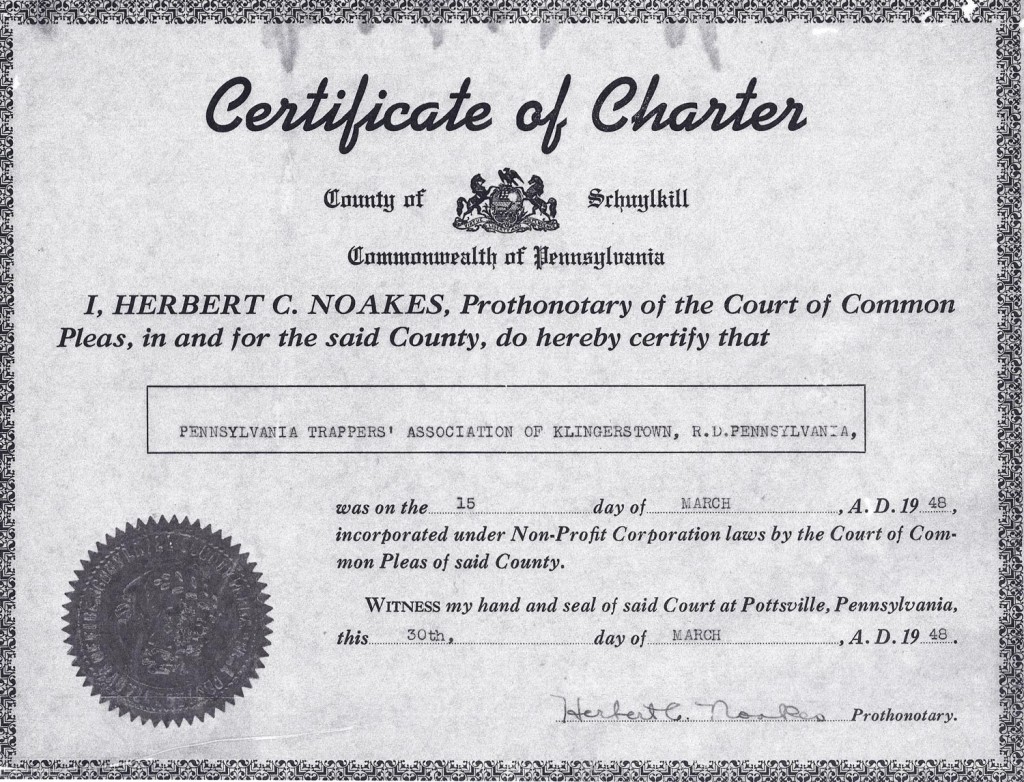About the PTA
The PTA is made up of eleven districts. Each district consists from five to seven counties and is under the supervision of a District Director. The eleven District Directors, the President, two Vice Presidents (East and West), the Secretary, Treasurer, Editor, Public Relations, NTA and FTA Directors make up the Board of Directors or Executive Committee. Their responsibilities include: to further the cause of the association, advance its aims and purpose, represent its members in legislative matter, formulate polices and designate the course of action of the organization.
History
In 1935 the AMERICAN TRAPPERS ASSOCIATION folded and a group of Pennsylvania trappers decided to organize a state organization. The symbol for the A.T.A was used with Pennsylvania and is still part of our logo today.
The certificate charter, issued on March 15, 1948, and the original By-laws, as amended, are still used today. Through correspondence, our association actually started in 1936, and the first meeting took place on June 25th, 1938. Since that initial meeting in Centre Hall, the PA Trappers Association has held a statewide convention each year, except for 1943 through 1945 while World War II was ongoing, and 2020 amid the COVID-19 pandemic. As the years have gone by, the convention, now termed “Rendezvous,” is a multi-day event with attendees gathering from all corners of the continent.
PTA Accomplishments in Brief
The Pennsylvania Trapper’s Association gathers information from its membership and makes recommendations to the PA Game Commission for trapping seasons and bag limits. The Pennsylvania Trappers Association grew from just a handful of trappers in 1936 to become the largest state Trapper’s organization in the United States. Many of our ideas and concepts have been employed are are still in use by other state and national organizations.
The aims and purposes of the organization are as follows:
- To develop leadership for the advancement of the best interest of the trappers in the fur industry as a whole.
- To inspire in our membership a desire to practice the ethics of the true sportsmanship toward others who wish to enjoy the recreation and the pleasures of the outdoor.
- To impart adequate knowledge to our youth concerning the necessity of conservation.
- To cooperate with duly recognized conservation organization and the furtherance of the objectives of the trapping fraternity.
- To advocate a comprehensive research program regarding the conservation of nature furbearing animals.
- To cultivate a feeling of goodwill and mutual understand through a proper respect of landowners at all time.
- Promote and demonstrate ethical and responsible treatment of wildlife at all times.
- To discourage and eliminate unjust and fraudulent trade practices and that the marketing of raw furs.
- To aid and cooperate with law enforcement agencies in bringing about the apprehension and just punishment of traps and fur thieves and other game law violators pertaining to trapping.
- To oppose and demand revision or repeal of any law or regulation which is based or discriminate toward the trapping fraternity.
- To oppose any proposed legislation which would impose unreasonable restrictions on the taking of furbearing animals or the sale of pelts thereof; to demand the revision or repeal of any existing law or regulation of the same nature.
- To encourage the conservation of our wild furbearing resources.
- To oppose any individual or any organization whose activities are motivated by avarice or fanaticism or who designs are detrimental to the interest.

